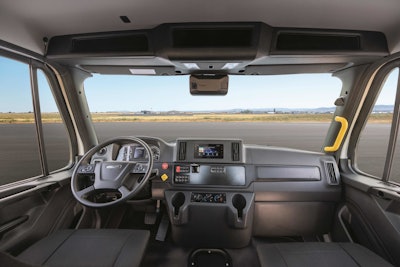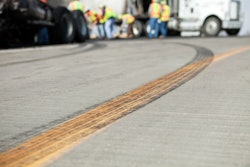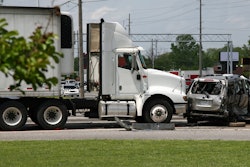
Officials from Daimler Truck North America, Geico, and Hirschbach Motor Lines took part in a panel discussion at the 2024 American Trucking Association (ATA) conference in Nashville, Tennessee to discuss the importance of vehicle safety systems and why it's important for them to provide insurers access to telematics data in order to bring down fleets' insurance costs.
Panel participants, led by moderator Tobias Waldeck of Daimler Truck Financial, answered questions regarding driver assistance technologies and how they can lower insurance rates, driver acceptance of those technologies, and the impact of ongoing nuclear verdicts.
The panel included:
- Brad Pinchuk, CEO of Hirschbach Motor Lines
- Steve Collins, Daimler Truck's Director of Component Sales
- Sanjiv Khurana, Daimler Truck's General Manager, Connectivty/Digital Vehicle Solutions
- Rishi Arora, Head of Product & Pricing for Commercial Auto
- Chris Sions - Senior Director of Business Development, Geico
Safety tech and lower rates
Pinchuk explained that finding affordable insurance for smaller fleets continues to be a challenge as premiums keep increasing.
"We take on the first $10 million of any accident ourselves. A few years ago it was $100,000. And we're all familiar with large nuclear verdicts out there, which is one of the largest challenges. The best thing to do is avoid having accidents, do what we can to utilize technology, specifically collision avoidance systems and inward facing cameras. With cameras we found that over 90 percent of accidents weren't our fault."
The evolution of safety systems and greater adaption rates is all about creating safer roadways and a safer product for drivers, added Collins.
"Our particular role in active driver and safety systems began back in 2015 with with adaptive cruise control. Over time that product has evolved into a radar-based system that incorporates cameras and additional sensors into that suite. These systems are all about integrating with the driver, but they're not a get out of jail free card. The systems are a partner for the driver, not a replacement for an attentive, well-trained and rested driver. The more we can help fleets and drivers understand these systems, how they work, and knowing what they can't do means greater acceptance. Above all, drivers are always in control of the vehicle."
Khurana made clear that focusing on creating digital complements using data from customers is a major focus.
"Data from our trucks has been a key part of the equation for a long time. We've invested a lot in developing connectivity solutions. Today, over 1.3 million trucks around the world are connected to our platform. Uptime, efficiency, and safety are key parts of our equation and enabling those services by partnering with different folks around the world is critical. Partnerships are a key part.
With safety, as the architecture evolves, we've taken that data from trucks and developed a variety of safety products. We integrated video in the last couple of years. Today, cameras come built in so we integrated with our safety solutions. That's the evolution and there's more to come."
From an insurance provider's perspective, telematics data plays a significant role in helping to determine rates. In short, the more the vehicle is connected, the greater the likelihood for lower rates.
"Insurance companies have been trying to do telematics forever. We now offer a dash cam to our customers," said Sions. "Working with Daimler, we've realized just how much the trucks are being connected on a daily basis, specifically safety equipment. A lot of these trucks' safety equipment is getting more connected.
"How do we start using the safety technology of the telematics to make drivers safer? It's all about the safety of the driver."
Insurers and telematics
Privacy issues are a regular concern for private citizens and companies. Trucking is no different. Utilizing telematic data, however, is critical but there are challenges.
"How do you use greater data to bring more savings to the customer," Sions asked. "Another challenge is capacity, which requires well capitalized insurers to enter the market because trucking has a unique set of problems and risks. It's about technology and changing the way things are done."
OEMs play a major role because they not only provide critical software systems, but also hardware.
Following an accident involving one of its drivers, Pinchuk recalled that "we got a short cut of the video of the driver's accident, make sure it's not a false positive, and then speak to the driver a few days after the incident. We're using AI in our business where the technology is coaching drivers, and we've seen a 90 percent reduction of coachable events. We've got all of this data so how do we effectively use it to drive safe behavior? This case is a great example of how data can be utilized."
Ideally, Pinchuk would like to see more development of collision avoidance systems. "The tech wasn't anything like it is today only 10 years ago. Drivers used to complain about the system hitting the brakes, for example. But the tech continues to evolve over time and driver acceptance has improved. I'm also excited to see improved cameras to make these systems even more effective and accurate."
Insurance providers, including Geico, expect to see a reduction in the volume of claims.
"To me, the price of insurance is simple: how many accidents do we have? AI has the ability to bring down those rates by making the truck safer. As accidents come down, the price of insurance will come down," Sions added.
Driver acceptance
Technology is only useful if it's used properly, which is why fleets have invested in coaching for increased driver safety. Still, drivers need to understand there are benefits for them, which is often a challenge. One example is using adaptive cruise control.
"This wasn't a normal thing in the trucking industry not long ago," Collins said. "The ability for adaptive cruise control to manage driving in heavy traffic makes a difference. Those small little things over a 10-hour day of driving can add up quite a bit. We also have active lane assistance that provides active input into the steering column. It feels like power steering on steroids. That's part of the safety system. We can measure how much work the driver puts into the system."
Drivers who can finish their shift and realize they're not very tired because of safety systems provides a comfort benefit. Robustness and adding comfort benefits, Collins says, have played a key role regarding acceptance.
"How do we make sure fleet managers and drivers understand what's beneficial," Khurana stated. "Those are things we want to make sure our customers are aware of. The data and what insights it can provide are key to helping create a richer driving experience. We want to be able to take the best of what we have to offer and scale it."
Finding insurance
It's no secret insurance premiums in trucking are high, but the entry of new providers could bring down those rates.
"One of the things we realized is that there is a capacity constraint in the trucking industry," said Sions. "Geico has the backing and capital for this industry. We've been entering the trucking segment over the past two to three years and the whole effort is to give customers choice, bring more capacity to the market and give Geico the opportunity to diversify its product portfolio."
Many fleets, instead, opt to be largely self-insured due to the difficulty of finding affordable rates.
"There's a circular argument," Khurana said. "OEMs, insurance and small product companies are going around in circles. How do we break this? How do we make trucks safer and pass it on to the insurance company?"
Nuclear verdicts
Nuclear verdicts are hanging over this industry. It plagues the entire transportation sector, and many are understandably convinced trucking is being unfairly targeted. These verdicts are bad for everybody because the cost of trucking increases, and so will inflation. Is there a way out of this?
"Definitely one of the most important components is determining the cost of insurance. Nuclear verdicts and big verdicts in general definitely drive up the cost of insurance because we have to defend our customers," Arora explained. I am excited about things like dash cams for exoneration and driver defense purposes. Hopefully this will lead to a trend in lower insurance costs."
Unfortunately, nuclear verdicts are beyond anyone's control but what can be controlled is the use of technology.
Integrated cameras
There can be difference between integrated and aftermarket cameras, and the former is the preferred choice for most because of their better data quality. Proving an accident wasn't a driver's fault could potentially save millions.
"Having OEM integrated cameras with critical event time stamps allows for accurate video capture time," Collins said. "When it's an OEM integrated solution there are more efficiencies. Trucks equipped with safety systems is vital and there's more opportunity for greater acceptance of those systems. Those systems are now standard on all of our products."
Pinchuk couldn't agree more.
"We wouldn't buy a truck without a collision avoidance system and we wouldn't hire a driver that doesn't have a camera in the video. We've had so many situations when there's been an accident and the person lawyered up right away. We just send them the video and show them here's what happened and we're not at fault, and the issue often goes away. Just having the data at your fingertips prevents people from chasing something they can't win."
Having this data and video evidence available is important to show that the driver and carrier is doing everything they can to make things safer. They can also be good evidence when fighting against a possible nuclear verdict.
Still, all of the panel participants agreed that even with the combination of video and data, safety always starts with the driver.











